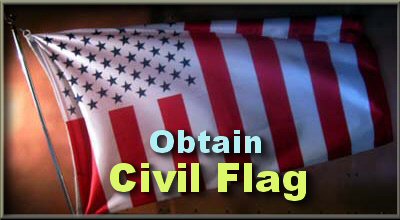Other exerpts inserted are from website 2 website 3
Go to said websites for a more exhaustive study pertaining to flags.
Early Flags
most Americans are not aware of
Prior to the beginning of the Revolutionary War, there was a decade or so of unrest in the British North American Colonies. The end of the French and Indian War in 1763 left a large debt that Parliment decided to pay by raising taxes directly on the colonies, since they were the primary beneficiary of the successful prosecution of the war. Taxes were imposed on a number of items, including legal documents, newspapers, lead, glass, paper and, of course, tea. Stamps were issued to be affixed at the time of the payment of taxes onto the legal documents and newspapers.
Beginning in 1765, protests of the duties and taxes and stamps required by Parliment began in the colonies. James Otis, in a famous speech characterized by John Adams as being "then and there was the child Independence born," before a court in Massachusetts proclaimed that it was a violation of God's law to impose "Taxation without Representation." Benjamin Franklin's embelem of a Rattlesnake cut into pieces with the motto "Unite or Die" was resurrected to remind the colonists of the effects of disunion.
Liberty trees and liberty poles were erected or dedicated and Liberty flags were flown. It was subsequent to a protest of the Stamp Act held under a particular Elm tree in Boston, known thereafter as "the Liberty Tree," that the Sons of Liberty were formed and they met under this tree. Later, the British cut the tree down but the Sons replaced it with a Liberty pole. Their flag of nine alternating red and white vertical stripes was flown from this pole. The flag is displayed today at the Old State House in Boston, folded, in a controlled environment case.
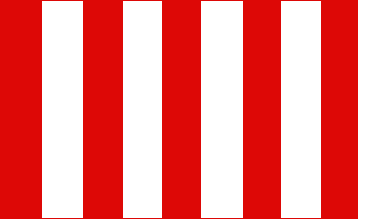
Flag of the Sons of Liberty
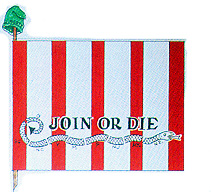 The flag above is still in existence. According to "Standards and Colors of the American
Revolution" by Edward W. Richardson (University of Pennsylvania Press and the Pennsylvania
Society of Sons of the Revolution and its Color Guard, 1982) the nine stripes could correspond
to nine segments of the cut up rattlesnake in the cartoon (representing New England, New York,
New Jersey, Pennsylvania, Maryland, Virginia, North Carolina, South Carolina and Georgia).
Unfortunately, the "Artist's Imaginative Sketch Showing the Possible Relation to Franklin's
and Revere's Disjointed Snake" has been picked up by other books and illustrated as a
9-vertical striped flag with the Rattlesnake and motto on it, labeled the flag of the Sons of
Liberty.
The flag above is still in existence. According to "Standards and Colors of the American
Revolution" by Edward W. Richardson (University of Pennsylvania Press and the Pennsylvania
Society of Sons of the Revolution and its Color Guard, 1982) the nine stripes could correspond
to nine segments of the cut up rattlesnake in the cartoon (representing New England, New York,
New Jersey, Pennsylvania, Maryland, Virginia, North Carolina, South Carolina and Georgia).
Unfortunately, the "Artist's Imaginative Sketch Showing the Possible Relation to Franklin's
and Revere's Disjointed Snake" has been picked up by other books and illustrated as a
9-vertical striped flag with the Rattlesnake and motto on it, labeled the flag of the Sons of
Liberty.
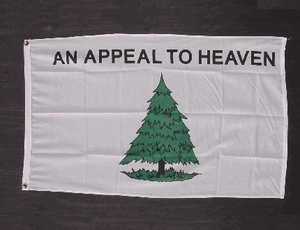
Liberty Tree Flag at left is a current reproduction.
In 1775, following a long history of local flags, the New England forces who were surrounding
Boston remembered their New England Flag, a red flag with a white
canton bearing a Pine Tree. Other versions of this flag were used, particularly on ships who
wore a white flag bearing the Pine Tree, sometimes with the motto "An Appeal to Heaven."
The earliest reference to this flag is apparently the raising of it on board the Continental ship "Alfred" on December 3, 1775 at Philadelphia supposedly by John Paul Jones. The flag was made by Margaret Manny of Philadelphia; she was paid one pound, two shillings and eight pence for her work on December 2, 1775.
On January 1st, 1776, General George Washington, who had been appointed to command the American
Army by the Continental Congress, ordered the hoisting of the "Union Flag in compliment to
the United Colonies" on a 76 foot tall pole on a hill in Somerville, just outside of Boston.
The flag he was talking about is known to us today as "the Continental Colors," and
was a British red ensign defaced by some white stripes, totalling 13 red and white stripes.
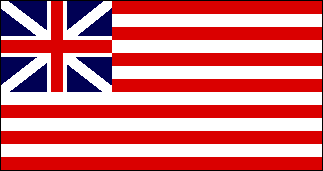
Continental Colors, 1775-1777
There is some conjecture that the stripes of the Sons of Liberty flag may have inspired the stripes on the Continental Colors but there is no documentary evidence of this.
Copies of a speech recently made by King George III, in which he called on Americans to lay down their arms, had just been sent to Washington's camp. The raising of this flag was noted by Washington thusly: "behold! it was received in Boston as a token of the deep Impression the Speech had made upon us, and as a signal of Submission ... by this time I presume they begin to think it strange that we have not made a formal surrender of our Lines ..." This flag, of course, was used as a sign of loyalty by Americans to traditional English values and laws, which the Americans were intent upon preserving.
Other references to this flag exist:
- The ship "Defense" flew it on March 12, 1776.
- It was raised over a captured fort in the Bahamas in March, 1776.
- The schooner "Royal Savage" flew it at Lake Champlain between August and October 1776.
- Captain Isaiah Robinson's ship received the first foreign recognition by a foreign power when the Dutch commander of the fort at St. Eustatius saluted the "Andrea Doria" flying the Continental Colors on November 16, 1776. In revenge, the enraged British Admiral Rodney completely devastated St. Eustatius, carrying off over one hundred million dollars worth of goods.
- Currency in the denomination of seven and one half dollars issued by the State of North Carolina illustrated it in April, 1777.
- Some version of it apparently was used during the defense of Fort Schulyer in August, 1777.
- The Continental brigantine "Lexington" flew a version of it with red, white and blue stripes when captured September 19, 1777.
- This version with the tri-colored stripes appears on John Paul Jones' Coat of Arms preserved in the Masonic Library in Boston that was supposedly drawn some time during 1776-1777.
It should be noted that the Continental Colors officially passed from existence on June 14, 1777 when the Stars and Stripes were born, however there are a few documented uses of it after that date, as noted.
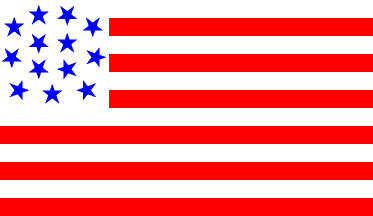
The use of blue stars in this flag of the Revolutionary period suggests militia use.
The omission of the thirteenth stripe probably indicates the loss of a state to the
British during the conflict.
The band at the bottom was added in 1880 during the presidential campaign of that year,
when Winfield Scott English (a former Civil War general)
and William Hayden English ran on the Democratic ticket.--Info and image by Blas Delgado Ortiz, 27 July 2001
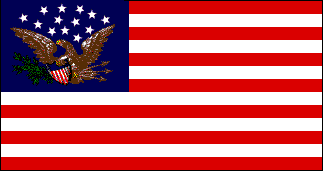
Typical Eagle Standard
c.1824
In 1782, after much debate and many suggestions, the U.S. Congress adopted the Great Seal or Coat of Arms, which is still basically the same today (and which can be found on the reverse side of the one dollar bill). This design features the Bald Eagle holding a shield composed of 13 pales (vertical stripes) representing the states and a blue chief (upper third of the shield) representing Congress and, in the talons of the Eagle, a bundle of arrows and some olive branches representing the authority of Congress in matters of Peace and War.
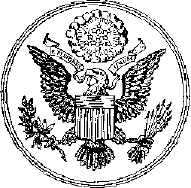
U.S. Seal adopted 1782
During the Revolutionary War, Washington corresponded on many occasions with the Board of War regarding "the standard of the U. States," but it was not until 1783 that such Standards were supplied to the army. The actual design of these Standards is not explicitly stated in the correspondence but can be infered from other sources. The New York Historical Society possesses a home-spun flag that is hand sewen and features a hand-painted Eagle reputedly of Revolutionary vintage. Although this flag has no authenticated history associated with it, it is similar in its details and construction to probably date from this period.
A Silk Standard of 13 white and red stripes with an Eagle Canton is in the possession of Independence Hall in Philadelphia. It's tradition states that it was presented by Congress to General Philip John Schuyler at the close of the Revolutionary War, probably sometime shortly after 1782.
A Medal presented in 1790 to General Daniel Morgan in honor of the victory at Cowpens, in 1781, shows three Eagle Standards.
By far the most important evidence of the usage of this design by the army comes from the Society of Cincinnati, the association of Continental Officiers formed in 1783. The Society's Diploma shows an Eagle Standard held by a warrior. Later, in 1786, the Society adopted "The Standard of the Society, of silk, imitating the Standard of the United States, having thirteen blue and white stripes alternate; in the upper corner of which to be painted the bald eagle."
Other sources also show variations of this design. Charles Wilson Peale, who served as a captain in the Revolutionary War, painted many portraits during the war and some of these show this flag. Specifically, a portrait of Lieutenant Colonel Samuel Smith of the Maryland Militia (in possession of Independence Hall) and a large group portrait (now in the State House at Annapolis) showing Washington, Lafayette, and Colonel Tench Tilghman at Yorktown.
A famous drawing by J. F. Renault of the surrender at Yorktown, made sometime before 1824, shows an Eagle Flag.
After the Revolutionary War, this design became in usage a sort of government flag used to represent the soverign nature of these States. Even on ships, where the stars and stripes usually was supreme, the Eagle flag could be found on official holidays and on forts and installations representing the United States around the world. (See the painting by Jonathan Budington of the "Cannon House and Wharf" painted probably in 1812. Note the huge flag over the fort bears 17 stripes.)
Another eagle flag, still in use today, is the "ensign" of the United States Coast Guard, which was adopted in 1799 and modified in 1910 by the addition of a seal in the fly. It shows 16 vertical stripes (the correct number of states in 1799) with a white canton that has a blue eagle on it.
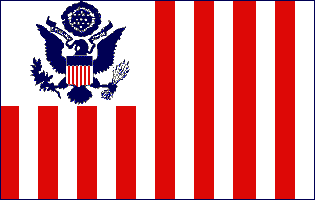
U.S. Coast Guard Ensign 1799-1910
Eagle Flags became quite popular during the period from c. 1800 until the Civil War. Many examples can be cited: the flag used by General John Fremont, the pathfinder of the west, which subtituted a calumet or peace pipe for the olive branches so that the Indians could understand the symbolism; many of the regimental flags used in the Mexican War were Eagle Standards; during the Civil War, Northern troops frequently fought under Eagle Standards, many of which are still preserved.
It was not until 1912, actually, when the Executive Department first issued specifications detailing the exact design for United States Flags that this emblem finally fell out of use.
It is regretable that this beautiful Flag design has recieved so little attention over the last few decades. The illustration at the head of this section is not a copy of any particular flag, rather it is a reconstruction of a type of flag design that may have been used c. 1824.
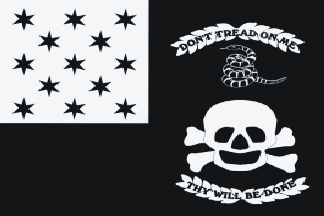 The Veteran Exempts flag was used in the War of 1812 at the Battle of Plattsburgh, New York.
The Veteran Exempts flag was used in the War of 1812 at the Battle of Plattsburgh, New York.
--Clifton Barrette, 2000
